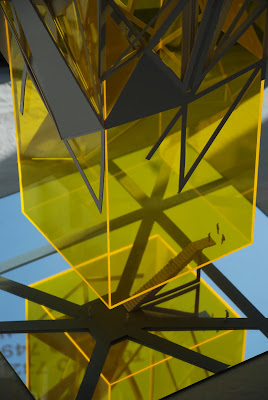The New Bailey was Sidell Gibson Architects' public vote winning entry to a design competition asking for iconic London landmarks to be re-imagined for the future.
Main Sponsor Haworth Office Furniture announced that Sidell Gibson has won its Iconic Buildings competition at Designers Saturday with their re-creation of the Old Bailey.
The Iconic Buildings competition ran alongside Haworth's 'Home Sweet Home' exhibition and invited a number of leading architectural and design companies (Gensler, Scott Brownrigg, BDP amongst others) to put forward alternative proposals in model form for a selection of London's most iconic buildings, such as Big Ben, The Gherkin and Tate Modern. Models and design boards were anonymous to allow visitors to consider the ideas behind the solution, as well as the visual appeal of the alternative building.
With a very clear lead, the winners were Sidell Gibson Architects with their re-design of the Old Bailey - 'The New Bailey'.
The solution looked to express:
- Transparency of the legal process
- Dynamic equilibrium expressed by a kinetic structure
- The court room as a jewel, a pure form
- A place of question - expressed in the structure shape
- A civic space with direct public access
- Transparency of the legal process
- Dynamic equilibrium expressed by a kinetic structure
- The court room as a jewel, a pure form
- A place of question - expressed in the structure shape
- A civic space with direct public access
The Old Bailey: The past
The Old Bailey has been the site of a court of justice since medieval times starting originally as the Justice Hall, then the Sessions House and finally the Central Criminal Court. Its name relates to its location on Old Bailey Street and it’s construction along the line of the fortified Roman city wall, called the “bailey”.
The original medieval courthouse, destroyed by the Great Fire of London in 1666, was rebuilt in 1673 and permitted the litigants, witnesses and court personnel to assemble together at the front in the Sessions House
Yard. The courtroom was open on one side, enabling better ventilation to prevent the possibility of contracting “gaol fever” or typhoid from the prisoners. Spectators could also gather in the Yard to view the Proceedings, for which they paid a fee.
The Old Bailey has been the site of a court of justice since medieval times starting originally as the Justice Hall, then the Sessions House and finally the Central Criminal Court. Its name relates to its location on Old Bailey Street and it’s construction along the line of the fortified Roman city wall, called the “bailey”.
The original medieval courthouse, destroyed by the Great Fire of London in 1666, was rebuilt in 1673 and permitted the litigants, witnesses and court personnel to assemble together at the front in the Sessions House
Yard. The courtroom was open on one side, enabling better ventilation to prevent the possibility of contracting “gaol fever” or typhoid from the prisoners. Spectators could also gather in the Yard to view the Proceedings, for which they paid a fee.
Remodelling occurred in 1737, including enclosure of the courtroom and construction of a secure link to Newgate Prison where prisoners were held and brought to the Old Bailey for trial. The enclosure of the courtroom resulted in the deaths of 60 people from “gaol fever”, including the Lord Mayor and 2 judges. George Dance the Younger rebuilt the Old Bailey in 1774 and the number of courtrooms was subsequently increased from one to four.
Another fire in 1877 led to the demolition of the Court House and Newgate Prison, both replaced in 1907 by the Central Criminal Court building. The new design featured the 12ft high gold “Lady Justice” who holds a sword in one hand and the scales of justice in the other. This has become the iconic image of the criminal justice system in the UK.
The New Bailey: The future
The current building is therefore just a snapshot in time and a consequence of numerous interventions.
Criminal Justice and Legal Statutes continue to evolve in response to social and political pressures within the framework of British Common Law with the contemporary recourse to the European Courts of Justice. The function of law, through wisdom and truth, provides the guidelines that enable order rather than anarchy to prevail as the background to civilised life.
The iconic New Bailey manifests these ideals in a design, which expresses the following: dynamic evolution and a sense of balance, as portrayed by the “Lady of Justice” . transparency of the ideal legal process, supported by the administrative framework. the courtroom as a jewel, a pure form; an aspiration for the public’s sense of justice dynamic equilibrium of precedent and change expressed by a kinetic structure a place of question and debate expressed in the structure’s shape – guilty or not guilty? a civic space - Justice Square - from which direct public access is gained to the courts.
The Iconic New Bailey no longer gives the impression of being a monolithic, fortified and secretive institution – rather it is revealed as a dynamic assembly of its integral parts, visible to all, and supported by the Pillar of Justice, provided courtesy of the Haworth showroom.






No comments:
Post a Comment
Note: only a member of this blog may post a comment.